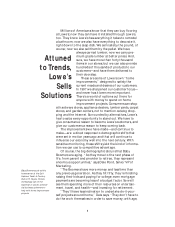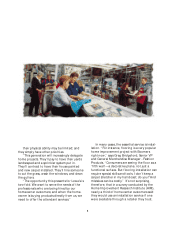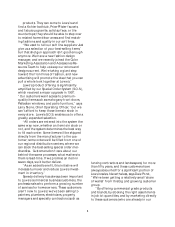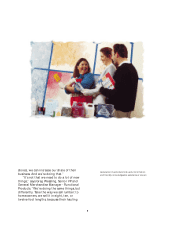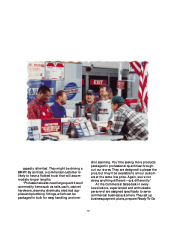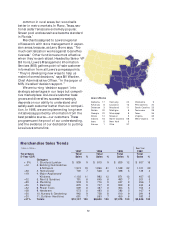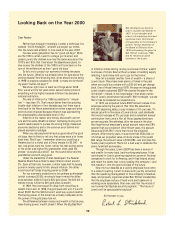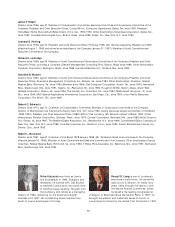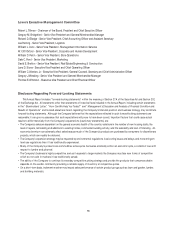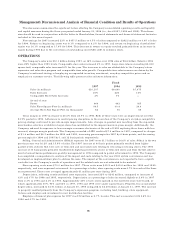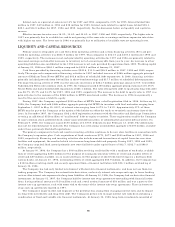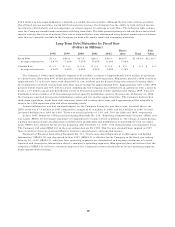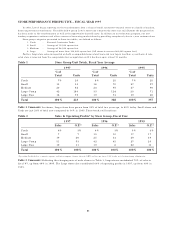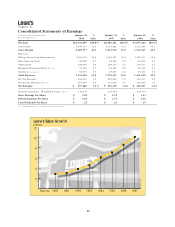Lowe's 1997 Annual Report Download - page 15
Download and view the complete annual report
Please find page 15 of the 1997 Lowe's annual report below. You can navigate through the pages in the report by either clicking on the pages listed below, or by using the keyword search tool below to find specific information within the annual report.
Looking Back on the Year 2000
Dear Reader:
Rather than indulge in nostalgia, I prefer a technique I’ve
dubbed “ 20/20 hindsight,” wherein we project our minds
into the future and attempt to look
back
at the year 2000!
You see, every generation has its “ good old days.” Mine
are the 1950’s, when I went to college, got married, and
joined Lowe’s. My children now feel the same way about the
1970’s and ‘80’s that I feel about the Eisenhower years. In
due course, the children of the 1990’s will look back on the
turn of the millennium as their “ good old days.”
So let’s try to project our economic thinking ten years
into the future. What do we already know for sure about the
coming decade? And knowing that, what should we be doing
in 1998 to prepare ourselves for 2008, to make the forthcom-
ing years “ better old days” ?
We know, right now, at least two things about 2008.
First, we all will be ten years older; second, dollar prices of
everything will be higher, because inflation has become a
national institution.
The rate of inflation for 1998 is predicted to “ remain
low” — less than 3%. That’s much better than the spiraling
double-digit inflation of two decades ago, but there was a
time back in the Nixon administration when wage and price
controls were imposed because inflation was approaching
the unacceptable, unendurable level of 4%!
Inflation is the reason why money and wealth are not
one and the same. Wealth is better! Confusing money with
wealth leads people to pursue the wrong things, make bad
economic decisions, and is the common error behind mis-
placed economic nostalgia.
When you ask people what was so good about the good
old days, they’re likely to tell you that prices were a lot lower
back then. They’ll say “ I remember when you could buy a
Hershey bar for a nickel and a Chevy Impala for $3,000.” In
fact, real prices were not lower: rather, the real buying power
of the dollar was higher. My grandfather often used the
phrase “ as sound as a dollar,” but the sound dollar and my
grandfather are both long gone.
Under the leadership of Alan Greenspan, the Federal
Reserve Board has worked to keep inflation down around
3%. Even at that rate, however, a dollar loses half its buying
power in twenty years! At 6% annual inflation, the dollar
would lose half today’s buying power by 2008!
For our economic projections to be as sharp as hindsight
(which is always 20/20), we should bear in mind the differ-
ence between a $20 bill and a $20 gold piece. The $20 bill is
merely money, while the $20 gold piece is wealth.
In 1928, they were equal in value: both would buy a
decent man’s suit. In 1998, the gold piece still will: it’s worth
about $500! But the $20 bill won’t even buy a good necktie!
The buying power of the dollar has virtually collapsed, while
the power of the gold piece has not.
The difference between money and wealth is that money
loses buying power; wealth doesn’t. When the Big Bad Wolf
Bob Strickland was hired by
Lowe’s founder Carl Buchan in
1957. In four decades with
Lowe’s, his marketing skills and
expansive vision contributed
immeasurably to the company’s
growth. He was Chairman of
the Board of Directors from
1978 until passing the gavel to
Bob Tillman in January 1998,
and he remains an active
member of the board.
of inflation comes calling, money is a house of straw; wealth
is a house of bricks. Even without a career in building supply
retailing, I could have told you to go for the bricks!
Now let’s consider another form of wealth— a share of
Lowe’s stock. There have been plenty of times in the past
when you could buy a share with a $20 bill and get change
back. One of those times was 1978, the year we inaugurated
Lowe’s highly acclaimed ESOP. We created the plan in the
firm belief— indeed, in the
knowledge
— that share owner-
ship in Lowe’s constituted real wealth. With hindsight, we see
that it has far exceeded our expectations.
In 1978, we projected future ESOP account values of an
employee entering the plan at that time. We assumed a
$10,000 beginning salary, a pay increase of 5% per year, 7%
annual growth in the value of Lowe’s stock, cash dividends
that would increase at 3% per year, and a consistent annual
contribution from Lowe’s. Not all those assumptions have
proven accurate. Nevertheless, after ten years in the plan,
that hypothetical employee’s actual account value was 28%
greater than our projection. After fifteen years, the account
value was $133,290— more than twice the projected
amount. After twenty years, it was more than $550,000, or
4.5 times our projected value. At stock prices in the recent
$65 range, the account value is $750,880, over six times the
twenty-year projection! That’s not a bad way to celebrate the
plan’s twentieth anniversary.
Through the years, Lowe’s ESOP has been a source of
real wealth for many loyal, hard-working employees. It has
contributed to Lowe’s growing reputation as one of the best
companies to work for in America, and it has helped attract
and retain the talent that is now leading this company— and
this industry—into the good old days of the future.
Now my four decades as a Lowe’s employee have come
to a close. In parting, I want to share with you my conviction
that the operating management of this company is talented,
deep, and properly organized under Bob Tillman’s leadership;
that the employee culture of hard work and teamwork is
working more successfully than ever; and that the words of
our founder Carl Buchan are still prophetic: “ The future of
Lowe’s will be spectacularly fabulous!”
All the best to you,
15
13




